Project Management Methodologies: Agile vs. PMBOK Analysis
VerifiedAdded on 2021/04/17
|8
|1420
|143
Report
AI Summary
This report delves into the realm of project management methodologies, providing a comprehensive overview of different approaches. The report begins by defining project management methodologies, emphasizing their crucial role in guiding project development and success. It then compares and contrasts two prominent methodologies: Agile and the Project Management Body of Knowledge (PMBOK), highlighting their strengths and weaknesses. The report further examines the relationship between Agile methodology and the project life cycle (PLC), illustrating how Agile principles are integrated across various project phases, including planning, execution, and closure. The analysis underscores the importance of selecting the appropriate methodology based on project requirements and goals. The report concludes by emphasizing how project management methodologies enhance employee performance, aid in decision-making, and contribute to project efficiency.
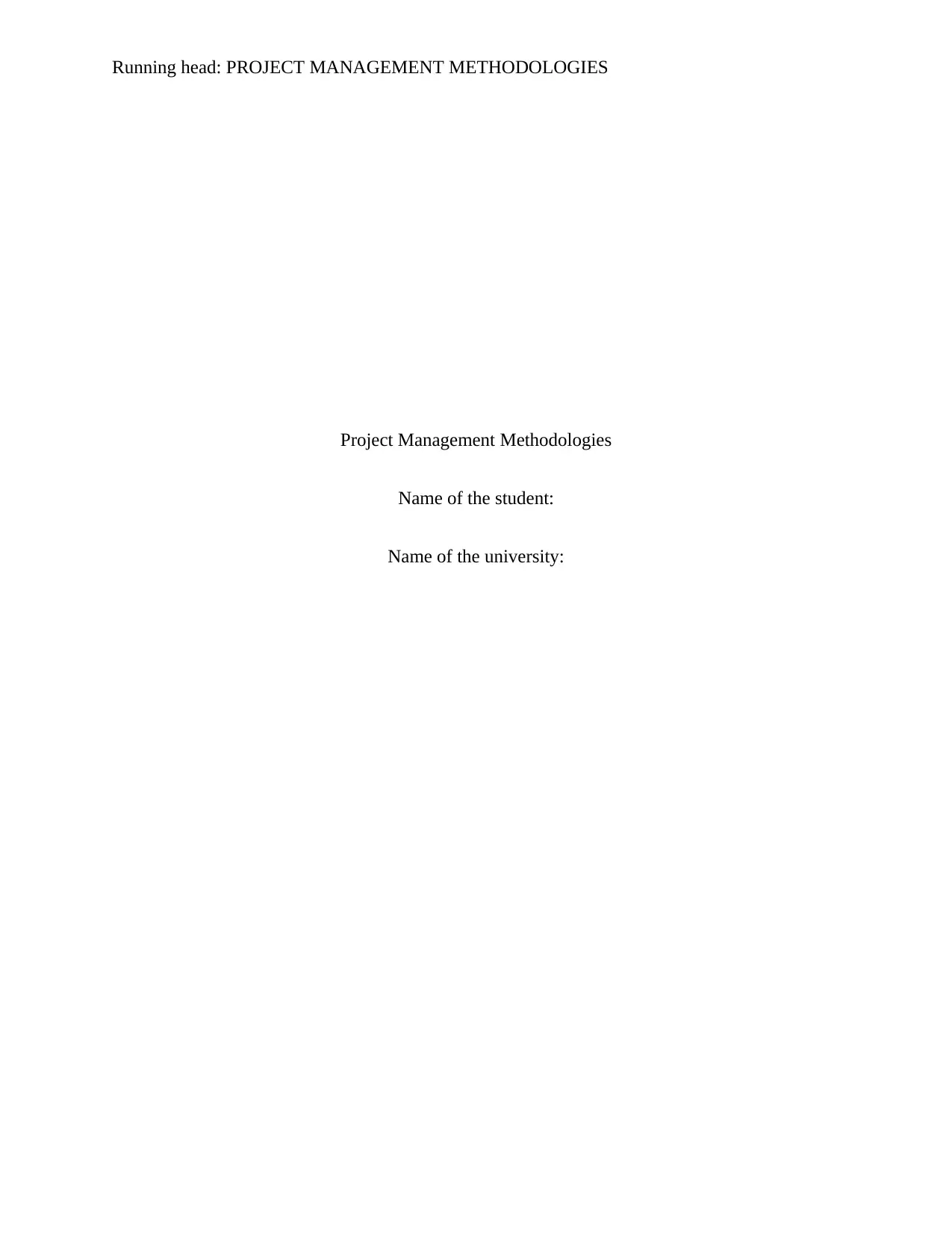
Running head: PROJECT MANAGEMENT METHODOLOGIES
Project Management Methodologies
Name of the student:
Name of the university:
Project Management Methodologies
Name of the student:
Name of the university:
Paraphrase This Document
Need a fresh take? Get an instant paraphrase of this document with our AI Paraphraser
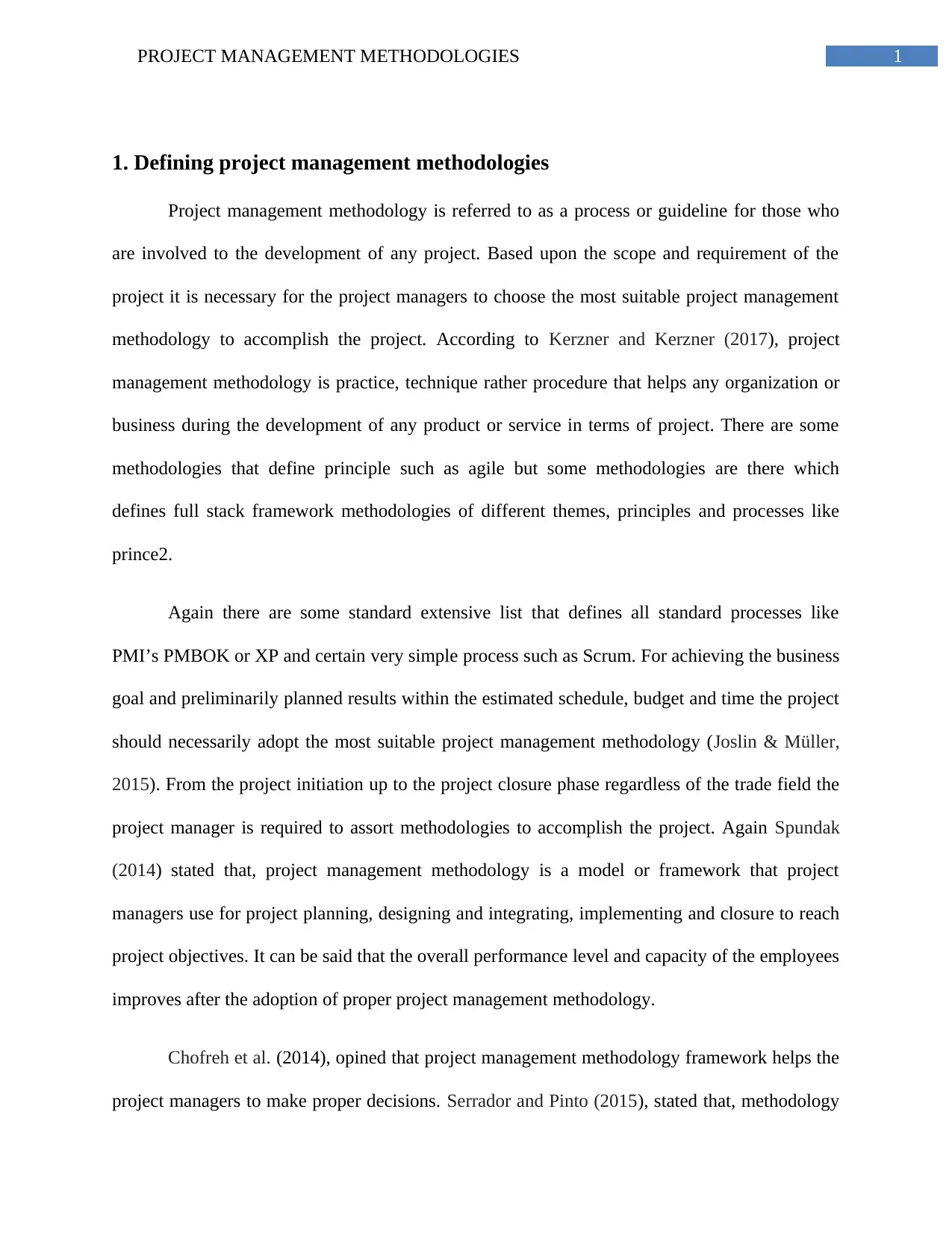
1PROJECT MANAGEMENT METHODOLOGIES
1. Defining project management methodologies
Project management methodology is referred to as a process or guideline for those who
are involved to the development of any project. Based upon the scope and requirement of the
project it is necessary for the project managers to choose the most suitable project management
methodology to accomplish the project. According to Kerzner and Kerzner (2017), project
management methodology is practice, technique rather procedure that helps any organization or
business during the development of any product or service in terms of project. There are some
methodologies that define principle such as agile but some methodologies are there which
defines full stack framework methodologies of different themes, principles and processes like
prince2.
Again there are some standard extensive list that defines all standard processes like
PMI’s PMBOK or XP and certain very simple process such as Scrum. For achieving the business
goal and preliminarily planned results within the estimated schedule, budget and time the project
should necessarily adopt the most suitable project management methodology (Joslin & Müller,
2015). From the project initiation up to the project closure phase regardless of the trade field the
project manager is required to assort methodologies to accomplish the project. Again Spundak
(2014) stated that, project management methodology is a model or framework that project
managers use for project planning, designing and integrating, implementing and closure to reach
project objectives. It can be said that the overall performance level and capacity of the employees
improves after the adoption of proper project management methodology.
Chofreh et al. (2014), opined that project management methodology framework helps the
project managers to make proper decisions. Serrador and Pinto (2015), stated that, methodology
1. Defining project management methodologies
Project management methodology is referred to as a process or guideline for those who
are involved to the development of any project. Based upon the scope and requirement of the
project it is necessary for the project managers to choose the most suitable project management
methodology to accomplish the project. According to Kerzner and Kerzner (2017), project
management methodology is practice, technique rather procedure that helps any organization or
business during the development of any product or service in terms of project. There are some
methodologies that define principle such as agile but some methodologies are there which
defines full stack framework methodologies of different themes, principles and processes like
prince2.
Again there are some standard extensive list that defines all standard processes like
PMI’s PMBOK or XP and certain very simple process such as Scrum. For achieving the business
goal and preliminarily planned results within the estimated schedule, budget and time the project
should necessarily adopt the most suitable project management methodology (Joslin & Müller,
2015). From the project initiation up to the project closure phase regardless of the trade field the
project manager is required to assort methodologies to accomplish the project. Again Spundak
(2014) stated that, project management methodology is a model or framework that project
managers use for project planning, designing and integrating, implementing and closure to reach
project objectives. It can be said that the overall performance level and capacity of the employees
improves after the adoption of proper project management methodology.
Chofreh et al. (2014), opined that project management methodology framework helps the
project managers to make proper decisions. Serrador and Pinto (2015), stated that, methodology
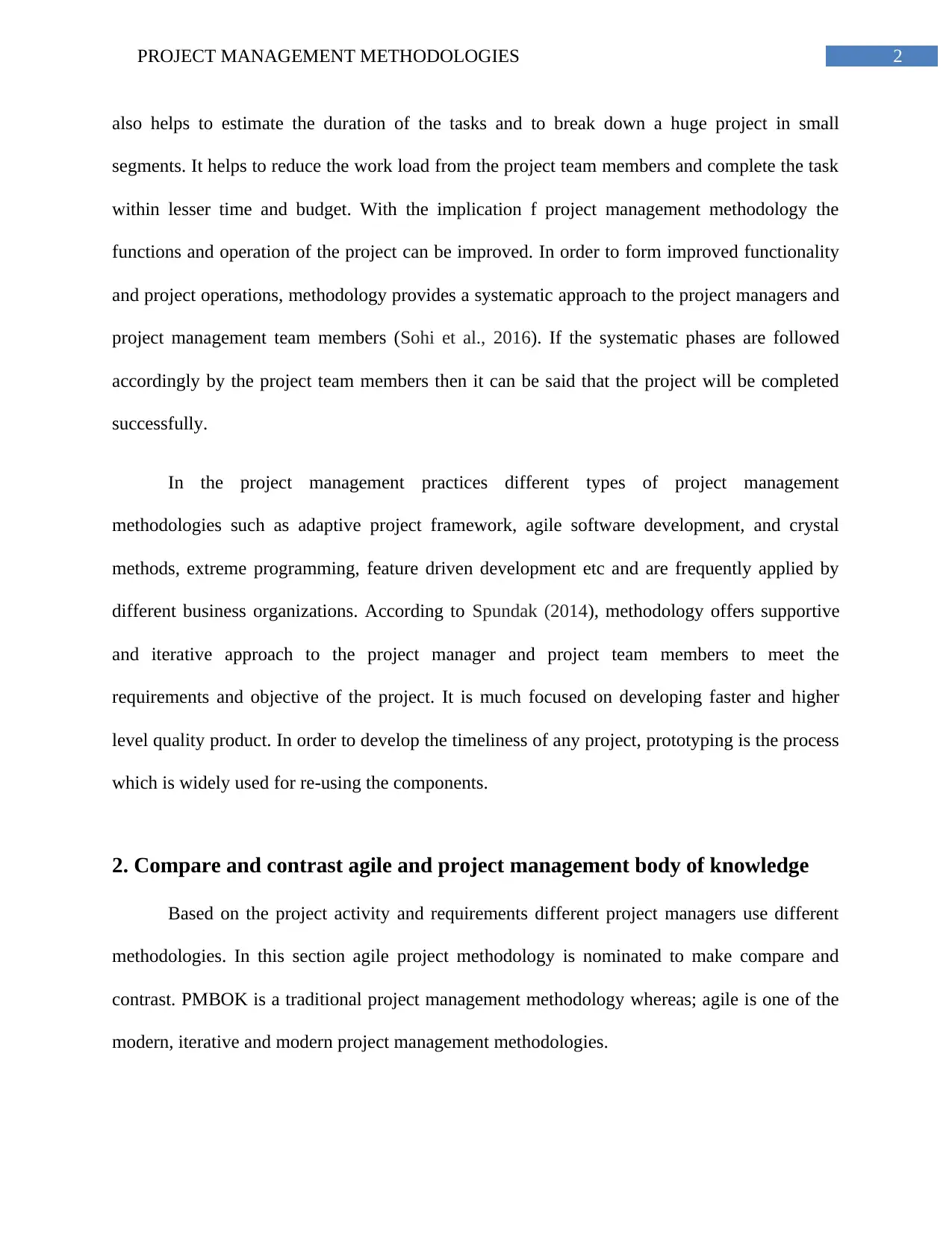
2PROJECT MANAGEMENT METHODOLOGIES
also helps to estimate the duration of the tasks and to break down a huge project in small
segments. It helps to reduce the work load from the project team members and complete the task
within lesser time and budget. With the implication f project management methodology the
functions and operation of the project can be improved. In order to form improved functionality
and project operations, methodology provides a systematic approach to the project managers and
project management team members (Sohi et al., 2016). If the systematic phases are followed
accordingly by the project team members then it can be said that the project will be completed
successfully.
In the project management practices different types of project management
methodologies such as adaptive project framework, agile software development, and crystal
methods, extreme programming, feature driven development etc and are frequently applied by
different business organizations. According to Spundak (2014), methodology offers supportive
and iterative approach to the project manager and project team members to meet the
requirements and objective of the project. It is much focused on developing faster and higher
level quality product. In order to develop the timeliness of any project, prototyping is the process
which is widely used for re-using the components.
2. Compare and contrast agile and project management body of knowledge
Based on the project activity and requirements different project managers use different
methodologies. In this section agile project methodology is nominated to make compare and
contrast. PMBOK is a traditional project management methodology whereas; agile is one of the
modern, iterative and modern project management methodologies.
also helps to estimate the duration of the tasks and to break down a huge project in small
segments. It helps to reduce the work load from the project team members and complete the task
within lesser time and budget. With the implication f project management methodology the
functions and operation of the project can be improved. In order to form improved functionality
and project operations, methodology provides a systematic approach to the project managers and
project management team members (Sohi et al., 2016). If the systematic phases are followed
accordingly by the project team members then it can be said that the project will be completed
successfully.
In the project management practices different types of project management
methodologies such as adaptive project framework, agile software development, and crystal
methods, extreme programming, feature driven development etc and are frequently applied by
different business organizations. According to Spundak (2014), methodology offers supportive
and iterative approach to the project manager and project team members to meet the
requirements and objective of the project. It is much focused on developing faster and higher
level quality product. In order to develop the timeliness of any project, prototyping is the process
which is widely used for re-using the components.
2. Compare and contrast agile and project management body of knowledge
Based on the project activity and requirements different project managers use different
methodologies. In this section agile project methodology is nominated to make compare and
contrast. PMBOK is a traditional project management methodology whereas; agile is one of the
modern, iterative and modern project management methodologies.
⊘ This is a preview!⊘
Do you want full access?
Subscribe today to unlock all pages.

Trusted by 1+ million students worldwide
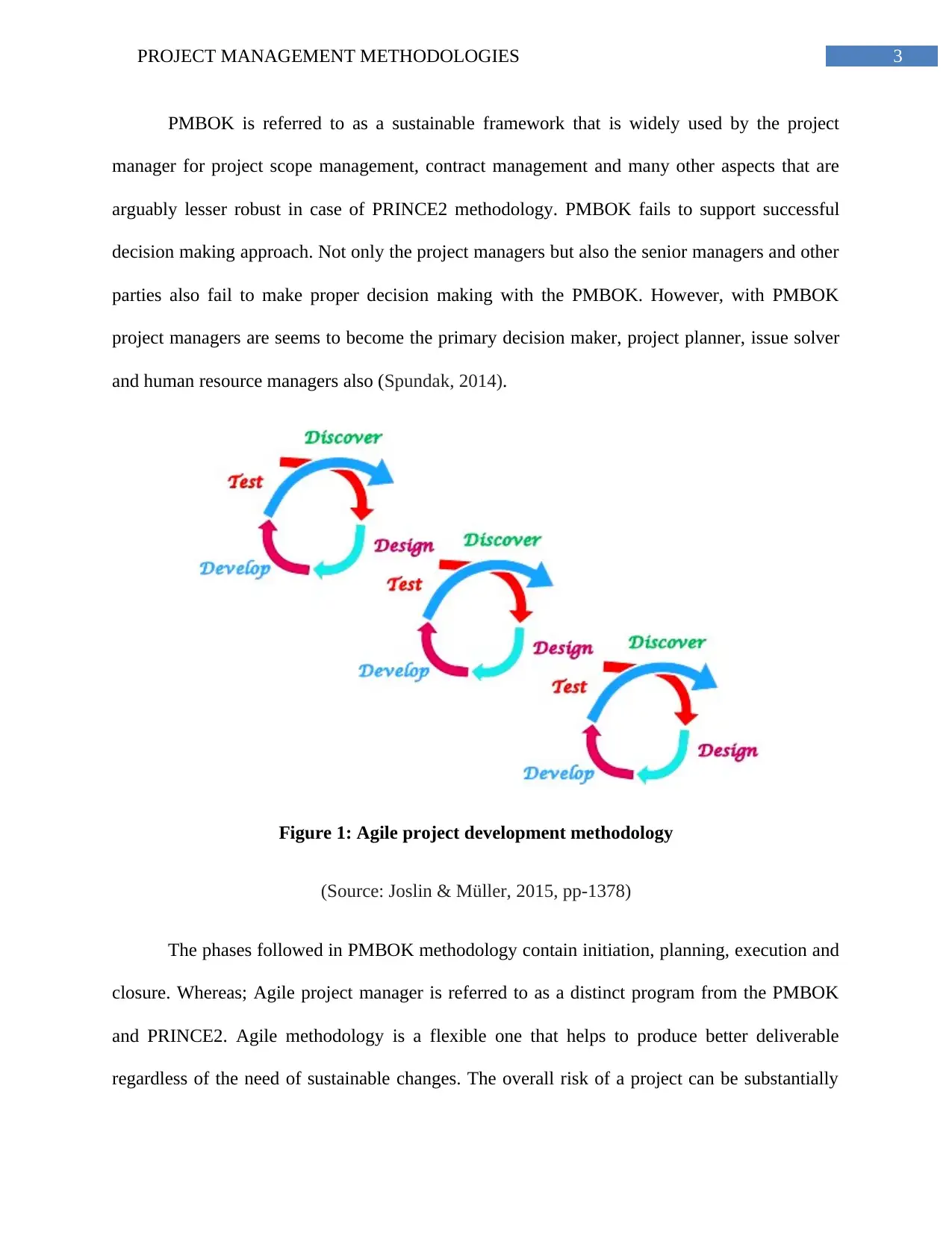
3PROJECT MANAGEMENT METHODOLOGIES
PMBOK is referred to as a sustainable framework that is widely used by the project
manager for project scope management, contract management and many other aspects that are
arguably lesser robust in case of PRINCE2 methodology. PMBOK fails to support successful
decision making approach. Not only the project managers but also the senior managers and other
parties also fail to make proper decision making with the PMBOK. However, with PMBOK
project managers are seems to become the primary decision maker, project planner, issue solver
and human resource managers also (Spundak, 2014).
Figure 1: Agile project development methodology
(Source: Joslin & Müller, 2015, pp-1378)
The phases followed in PMBOK methodology contain initiation, planning, execution and
closure. Whereas; Agile project manager is referred to as a distinct program from the PMBOK
and PRINCE2. Agile methodology is a flexible one that helps to produce better deliverable
regardless of the need of sustainable changes. The overall risk of a project can be substantially
PMBOK is referred to as a sustainable framework that is widely used by the project
manager for project scope management, contract management and many other aspects that are
arguably lesser robust in case of PRINCE2 methodology. PMBOK fails to support successful
decision making approach. Not only the project managers but also the senior managers and other
parties also fail to make proper decision making with the PMBOK. However, with PMBOK
project managers are seems to become the primary decision maker, project planner, issue solver
and human resource managers also (Spundak, 2014).
Figure 1: Agile project development methodology
(Source: Joslin & Müller, 2015, pp-1378)
The phases followed in PMBOK methodology contain initiation, planning, execution and
closure. Whereas; Agile project manager is referred to as a distinct program from the PMBOK
and PRINCE2. Agile methodology is a flexible one that helps to produce better deliverable
regardless of the need of sustainable changes. The overall risk of a project can be substantially
Paraphrase This Document
Need a fresh take? Get an instant paraphrase of this document with our AI Paraphraser
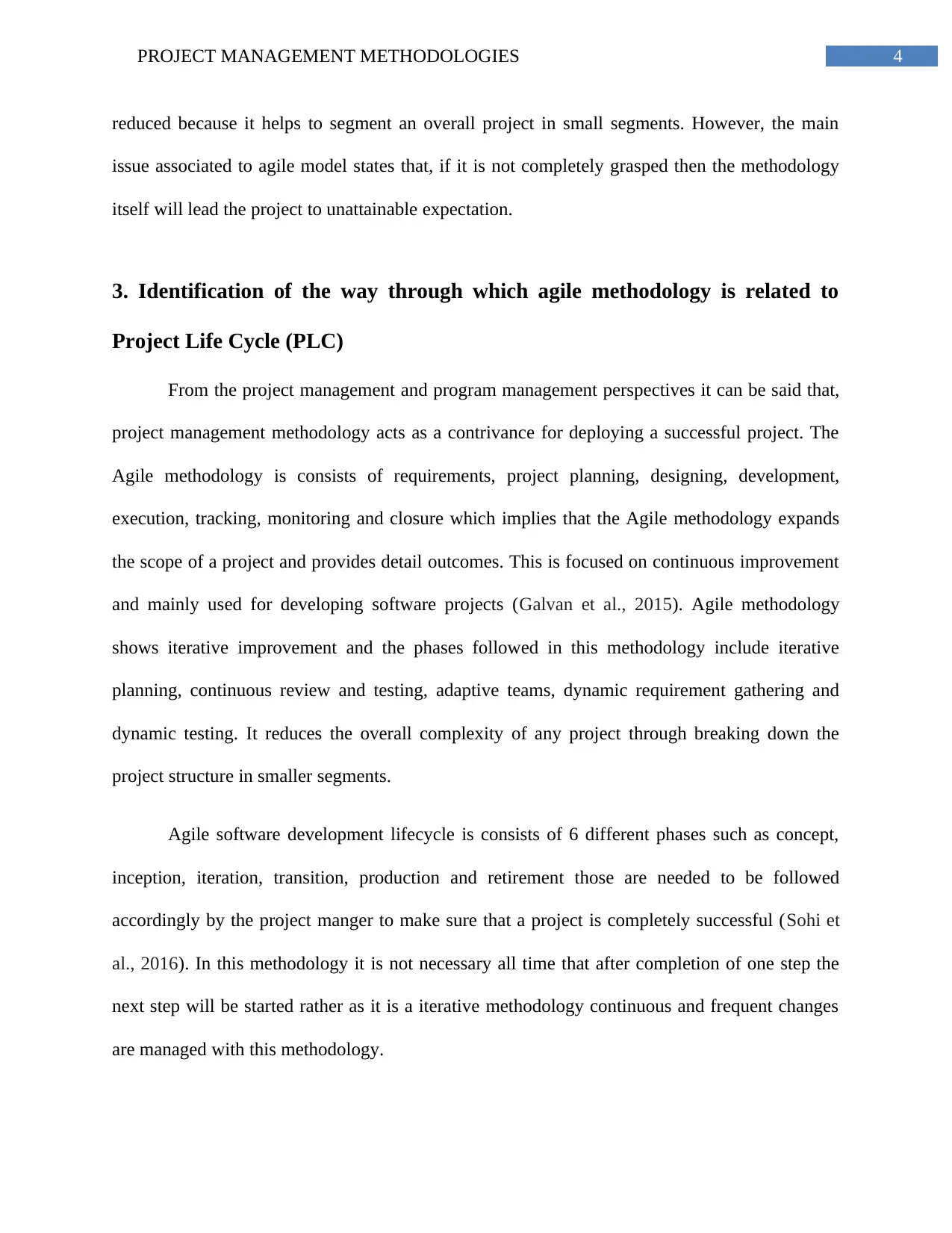
4PROJECT MANAGEMENT METHODOLOGIES
reduced because it helps to segment an overall project in small segments. However, the main
issue associated to agile model states that, if it is not completely grasped then the methodology
itself will lead the project to unattainable expectation.
3. Identification of the way through which agile methodology is related to
Project Life Cycle (PLC)
From the project management and program management perspectives it can be said that,
project management methodology acts as a contrivance for deploying a successful project. The
Agile methodology is consists of requirements, project planning, designing, development,
execution, tracking, monitoring and closure which implies that the Agile methodology expands
the scope of a project and provides detail outcomes. This is focused on continuous improvement
and mainly used for developing software projects (Galvan et al., 2015). Agile methodology
shows iterative improvement and the phases followed in this methodology include iterative
planning, continuous review and testing, adaptive teams, dynamic requirement gathering and
dynamic testing. It reduces the overall complexity of any project through breaking down the
project structure in smaller segments.
Agile software development lifecycle is consists of 6 different phases such as concept,
inception, iteration, transition, production and retirement those are needed to be followed
accordingly by the project manger to make sure that a project is completely successful (Sohi et
al., 2016). In this methodology it is not necessary all time that after completion of one step the
next step will be started rather as it is a iterative methodology continuous and frequent changes
are managed with this methodology.
reduced because it helps to segment an overall project in small segments. However, the main
issue associated to agile model states that, if it is not completely grasped then the methodology
itself will lead the project to unattainable expectation.
3. Identification of the way through which agile methodology is related to
Project Life Cycle (PLC)
From the project management and program management perspectives it can be said that,
project management methodology acts as a contrivance for deploying a successful project. The
Agile methodology is consists of requirements, project planning, designing, development,
execution, tracking, monitoring and closure which implies that the Agile methodology expands
the scope of a project and provides detail outcomes. This is focused on continuous improvement
and mainly used for developing software projects (Galvan et al., 2015). Agile methodology
shows iterative improvement and the phases followed in this methodology include iterative
planning, continuous review and testing, adaptive teams, dynamic requirement gathering and
dynamic testing. It reduces the overall complexity of any project through breaking down the
project structure in smaller segments.
Agile software development lifecycle is consists of 6 different phases such as concept,
inception, iteration, transition, production and retirement those are needed to be followed
accordingly by the project manger to make sure that a project is completely successful (Sohi et
al., 2016). In this methodology it is not necessary all time that after completion of one step the
next step will be started rather as it is a iterative methodology continuous and frequent changes
are managed with this methodology.

5PROJECT MANAGEMENT METHODOLOGIES
⊘ This is a preview!⊘
Do you want full access?
Subscribe today to unlock all pages.

Trusted by 1+ million students worldwide
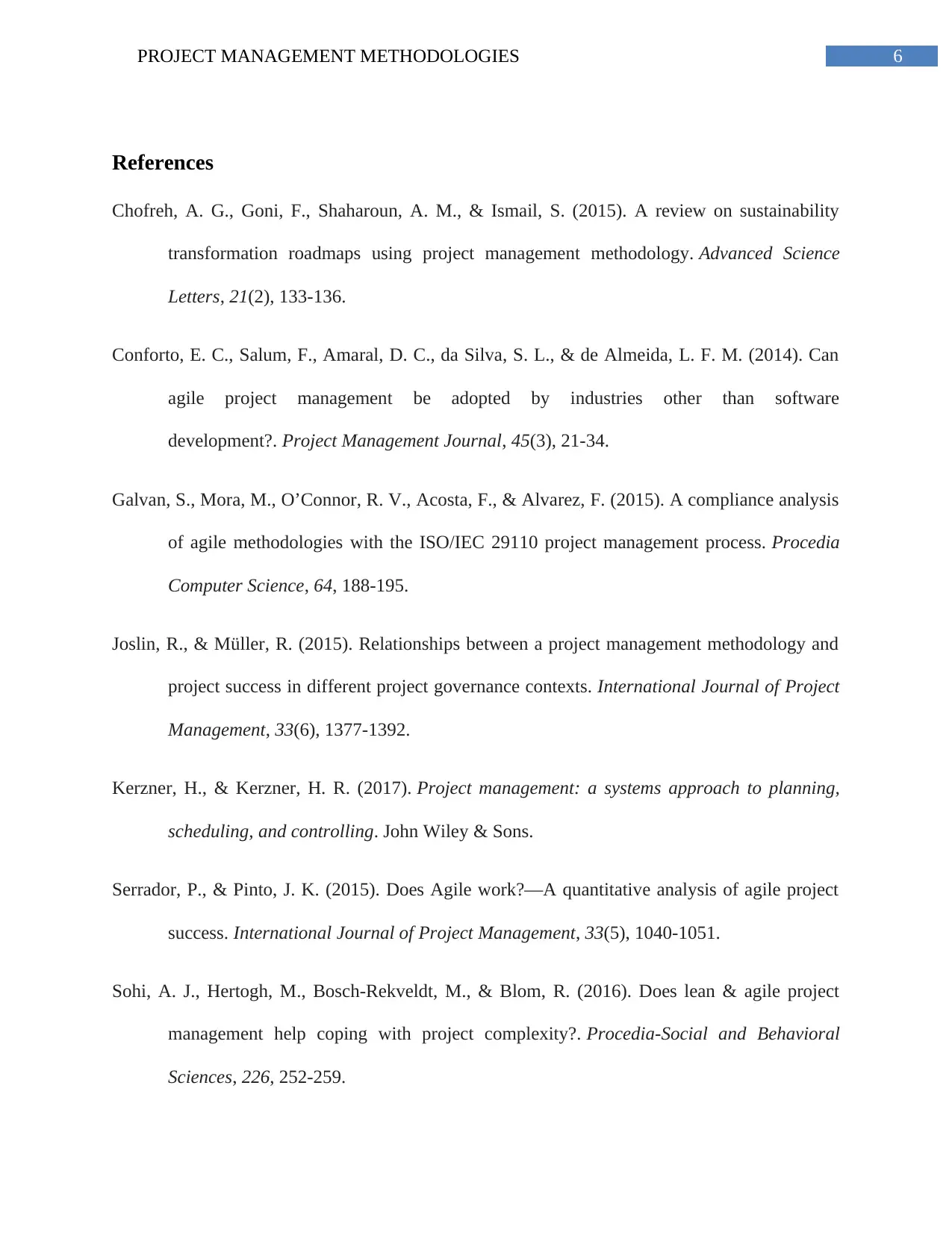
6PROJECT MANAGEMENT METHODOLOGIES
References
Chofreh, A. G., Goni, F., Shaharoun, A. M., & Ismail, S. (2015). A review on sustainability
transformation roadmaps using project management methodology. Advanced Science
Letters, 21(2), 133-136.
Conforto, E. C., Salum, F., Amaral, D. C., da Silva, S. L., & de Almeida, L. F. M. (2014). Can
agile project management be adopted by industries other than software
development?. Project Management Journal, 45(3), 21-34.
Galvan, S., Mora, M., O’Connor, R. V., Acosta, F., & Alvarez, F. (2015). A compliance analysis
of agile methodologies with the ISO/IEC 29110 project management process. Procedia
Computer Science, 64, 188-195.
Joslin, R., & Müller, R. (2015). Relationships between a project management methodology and
project success in different project governance contexts. International Journal of Project
Management, 33(6), 1377-1392.
Kerzner, H., & Kerzner, H. R. (2017). Project management: a systems approach to planning,
scheduling, and controlling. John Wiley & Sons.
Serrador, P., & Pinto, J. K. (2015). Does Agile work?—A quantitative analysis of agile project
success. International Journal of Project Management, 33(5), 1040-1051.
Sohi, A. J., Hertogh, M., Bosch-Rekveldt, M., & Blom, R. (2016). Does lean & agile project
management help coping with project complexity?. Procedia-Social and Behavioral
Sciences, 226, 252-259.
References
Chofreh, A. G., Goni, F., Shaharoun, A. M., & Ismail, S. (2015). A review on sustainability
transformation roadmaps using project management methodology. Advanced Science
Letters, 21(2), 133-136.
Conforto, E. C., Salum, F., Amaral, D. C., da Silva, S. L., & de Almeida, L. F. M. (2014). Can
agile project management be adopted by industries other than software
development?. Project Management Journal, 45(3), 21-34.
Galvan, S., Mora, M., O’Connor, R. V., Acosta, F., & Alvarez, F. (2015). A compliance analysis
of agile methodologies with the ISO/IEC 29110 project management process. Procedia
Computer Science, 64, 188-195.
Joslin, R., & Müller, R. (2015). Relationships between a project management methodology and
project success in different project governance contexts. International Journal of Project
Management, 33(6), 1377-1392.
Kerzner, H., & Kerzner, H. R. (2017). Project management: a systems approach to planning,
scheduling, and controlling. John Wiley & Sons.
Serrador, P., & Pinto, J. K. (2015). Does Agile work?—A quantitative analysis of agile project
success. International Journal of Project Management, 33(5), 1040-1051.
Sohi, A. J., Hertogh, M., Bosch-Rekveldt, M., & Blom, R. (2016). Does lean & agile project
management help coping with project complexity?. Procedia-Social and Behavioral
Sciences, 226, 252-259.
Paraphrase This Document
Need a fresh take? Get an instant paraphrase of this document with our AI Paraphraser

7PROJECT MANAGEMENT METHODOLOGIES
Spundak, M. (2014). Mixed agile/traditional project management methodology–reality or
illusion?. Procedia-Social and Behavioral Sciences, 119, 939-948.
Spundak, M. (2014). Mixed agile/traditional project management methodology–reality or
illusion?. Procedia-Social and Behavioral Sciences, 119, 939-948.
1 out of 8
Related Documents
Your All-in-One AI-Powered Toolkit for Academic Success.
+13062052269
info@desklib.com
Available 24*7 on WhatsApp / Email
![[object Object]](/_next/static/media/star-bottom.7253800d.svg)
Unlock your academic potential
Copyright © 2020–2025 A2Z Services. All Rights Reserved. Developed and managed by ZUCOL.





